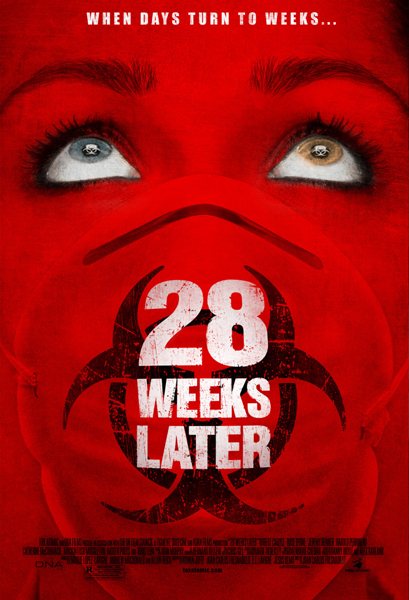 I never did write a real review of the popular Danny Boyle picture 28 DAYS LATER, just a little blurb in a summer recap column. To make a short story stay short, I liked it but did not understand the hooplah. It seemed to me most of it had already been done in Romero’s movies, and I liked it better when it was a real movie instead of a home video. So I was kind of annoyed by all the hype at the time that Boyle had “reinvented the zombie movie.” Even the controversial running zombies were straight out of RETURN OF THE LIVING DEAD. Somebody give Dan O’Bannon some credit. When he did that in 1985 it was a clever new take on zombies.
I never did write a real review of the popular Danny Boyle picture 28 DAYS LATER, just a little blurb in a summer recap column. To make a short story stay short, I liked it but did not understand the hooplah. It seemed to me most of it had already been done in Romero’s movies, and I liked it better when it was a real movie instead of a home video. So I was kind of annoyed by all the hype at the time that Boyle had “reinvented the zombie movie.” Even the controversial running zombies were straight out of RETURN OF THE LIVING DEAD. Somebody give Dan O’Bannon some credit. When he did that in 1985 it was a clever new take on zombies.
But I gotta tread carefully here because there are people out there who will flip out if you use the word “zombie” to describe the zombie-like people doing zombie things in this movie that is clearly based on the zombie films of George Romero. Zombies, it turns out, are people who die and then come back to life as zombies. They are not people who are infected and become zombies, unless they are infected to the point of death and then become zombies. In the case of these movies they just get infected, they do not necessarily die as far as we know, so they are something else. Nobody knows what it’s called, but it’s not a zombie. It’s just some thing that is exactly like a zombie and has every quality associated with zombies, but you can’t call it a zombie, that’s like using the N word almost. So I apologize to all the things who are not zombies but are exactly like zombies in all respects but they have not died and therefore are not zombies that I offended in my previous blurb. I will be more sensitive this time.
 (By the way, you zealots on this issue better go after the supposedly fact-based book and movie SERPENT AND THE RAINBOW, since they argue that real life Haitian zombies are people who have been given a poison that slows down their heart rate to make them appear dead, then they come back as zombies. They have not technically died and yet they are using the word zombie, you better make some signs and get down there.)
(By the way, you zealots on this issue better go after the supposedly fact-based book and movie SERPENT AND THE RAINBOW, since they argue that real life Haitian zombies are people who have been given a poison that slows down their heart rate to make them appear dead, then they come back as zombies. They have not technically died and yet they are using the word zombie, you better make some signs and get down there.)
Anyway, 28 WEEKS LATER is the sequel which is done by a different director but overseen by Boyle as a producer (and even second unit director). In this one we see the longer term results of the not-zombie diaster in London and also learn that significant events in the spread of the virus happen to always come in increments of 28 time units.
The movie opens back around the 28 days mark with a group of survivors holed up in a farm house, reminiscent of both NIGHT OF THE LIVING DEAD and some kind of hippie commune. Before long of course the house is attacked by infected non-zombie-yet-extremely-zombie-like individuals and the camera starts shaking and everybody screams and gets dizzy.
I’m no advocate of the shakycam, but I understand the stylistic reason for it in this case. These movies are meant to have a documentary-like look that theoretically would give the viewer more of a feeling of reality than in a real zombie movie done carefully and artistically on film. In theory it’s a good idea but in practice I don’t think the “it’s like COPS but you’re running from zombies” gimmick hits me in the gut like the existential dread of the characters hopelessly surrounded by unstoppable hordes of lumbering former humans in Romero’s world. Call me old fashioned.
Still, like any potentially dangerous technology, the shakycam can be put to good use or bad. 28 WEEKS LATER demonstrates both. Later on there are scenes where I had to wait 2 or 3 minutes to find out who exactly it was that got killed earlier when the camera was doing the watusi in a dark tunnel, but this opening escape from the farm house gets my seal of approval. Either they planned it well or they got real damn lucky, because they are able to have the panic and chaos of the handheld camera but also visually communicate what is going on, clearly showing Robert Carlyle hauling ass across a field and lines of, uh, angries forming on all sides.
It’s an intense scene that kicks the movie off with a bang, but not just because of the action. Here is a guy in a life or death situation who chooses selfishness over heroism. But he’s not the bad guy, he appears to be the protagonist. So instead of being 100% evil or Ellis-like it seems more like a profoundly weak and human moment. Here is Robert Carlyle, a likable guy, fairly handsome, capable of escaping the attack, should be a good movie hero – but he abandons his wife. He knows he should go back for her, but that he has a much better chance to escape if he doesn’t, so he doesn’t.
Then we skip to the 28 weeks later. London has been quarantined, the people who are like zombies have died off, the US Army has created a Green Zone type headquarters where the surviving refugees are being flown back in. Here Carlyle is reunited with his son and daughter. He’s some kind of medical bigshot, they stay in a hotel, they are happy to be together. You feel good for him but then they talk about their mother and he lies to them, claiming he saw her turn. Okay dude, we accepted that you were a coward but now you’re lying to your own children. You’re pushin it, buddy.
This is one of the things that made the movie interesting to me – he’s just such a flawed and complicated character. I think he really does love his family but he just can’t get past the fact that he’s a god damn coward. Whenever there’s a big disaster that happens you hear all kinds of stories of brave and selfless acts, feats of heroism. But what makes these stories news is that they are unusual. People are usually afraid to do that kind of shit. Carlyle is playing one of those normal guys who did not find it in him to become a hero, to do what he obviously should do. He was defeated by his fear.
And then things get more complicated for the family when the kids sneak out of the Green Zone, wander through the abandoned city to their house, and find their mother, still alive. Whoops. Dad had no way of knowing that she had a rare genetic trait that allowed her to be a carrier of the virus while being immune to its symptoms. So his story didn’t really check out.
From there of course the virus makes a comeback, the shit makes contact with the fan, and various zombie-like mayhem goes down. There’s alot of damn running in this world, it made me think I oughta get in better shape, just in case. There’s also a scene where a bunch of infecties get chopped up by a helicopter blade, which is kind of funny because 1. this also happened to the infected not-zombies in PLANET TERROR and 2. a helicopter blade chopped up a zombie in DAWN OF THE DEAD, and other elements of that scene were already lifted in 28 DAYS LATER. So the zombie vs. helicopter motif lives on. Now let’s bring back the zombie vs. shark from Fulci’s ZOMBI 2.
The movie stays intense and interesting throughout, and I think I liked it better than the first one. There are eerie scenes where our heroes run through the abandoned London streets chased not by the infected but by soldiers who should be protecting them. One minute you think they’re alone, the next an ominous cloud of gas floats from around the corner, and you know the faceless, masked soldiers are somewhere behind it. Man, that took me back to 1999 and the WTO protests, I never had a horror movie do that to me before.
That’s actually one thing I like better about this one and the thing that makes it more worthy of being compared to Romero. I had to check to see if the first one came before or after 9-11, because at least for me personally it didn’t do much to tap into the particular paranoia of the moment. (It came after, released here in the summer of 2003). This one, though, has all kinds of echoes of recent turmoil and in particular of the war in Iraq. The early scenes of American soldiers on lookout duty passing time by spying on the hotel residents through their rifle scopes says everything. These are good guys, they are there to help, but they are in a bad situation and they end up disrespecting and dehumanizing these people to the point that they don’t even think about it when they aim deadly weapons at them. It’s creepy because it’s true.
To me this was the most interesting stuff in the movie, the flawed character of the people and the operation they put in place. So as the movie goes along and by definition has to get more involved in the mechanics of people running in terror trying not to get bit it did lose a little bit of steam for me. Still, an intelligent and worthy sequel. I will definitely watch 28 FORTNIGHTS LATER or 28 FRIDAYS LATER (starring Ice Cube) or whatever they come up with for the next one.


























October 15th, 2010 at 12:48 pm
This movie should never have been made. It is not as good as the original and does not expanded the story enough to be topical with the exception of the infection spreading to Europe. The “zombies” in 28 days and weeks later are more vulnerable then the normal zombies because they can be killed as easily as normal people and they still breathe. They will also starve and dehydrate in days so they are not as dangerous despite their running and agility. The “zombies” can also tolerate sunlight in this movie (they couldn’t in 28 days later) and no only is this change not explained but the movie acts as if the “zombies” in the first movie could always walk in day light even though the fact they couldn’t was a huge part of the first movie. That’s negligent and rude to the viewers.